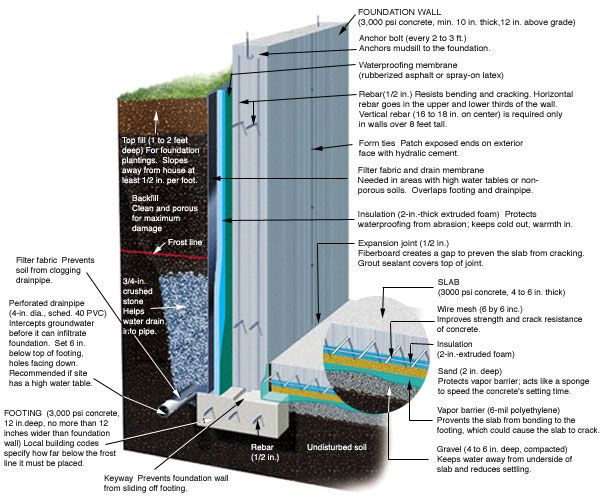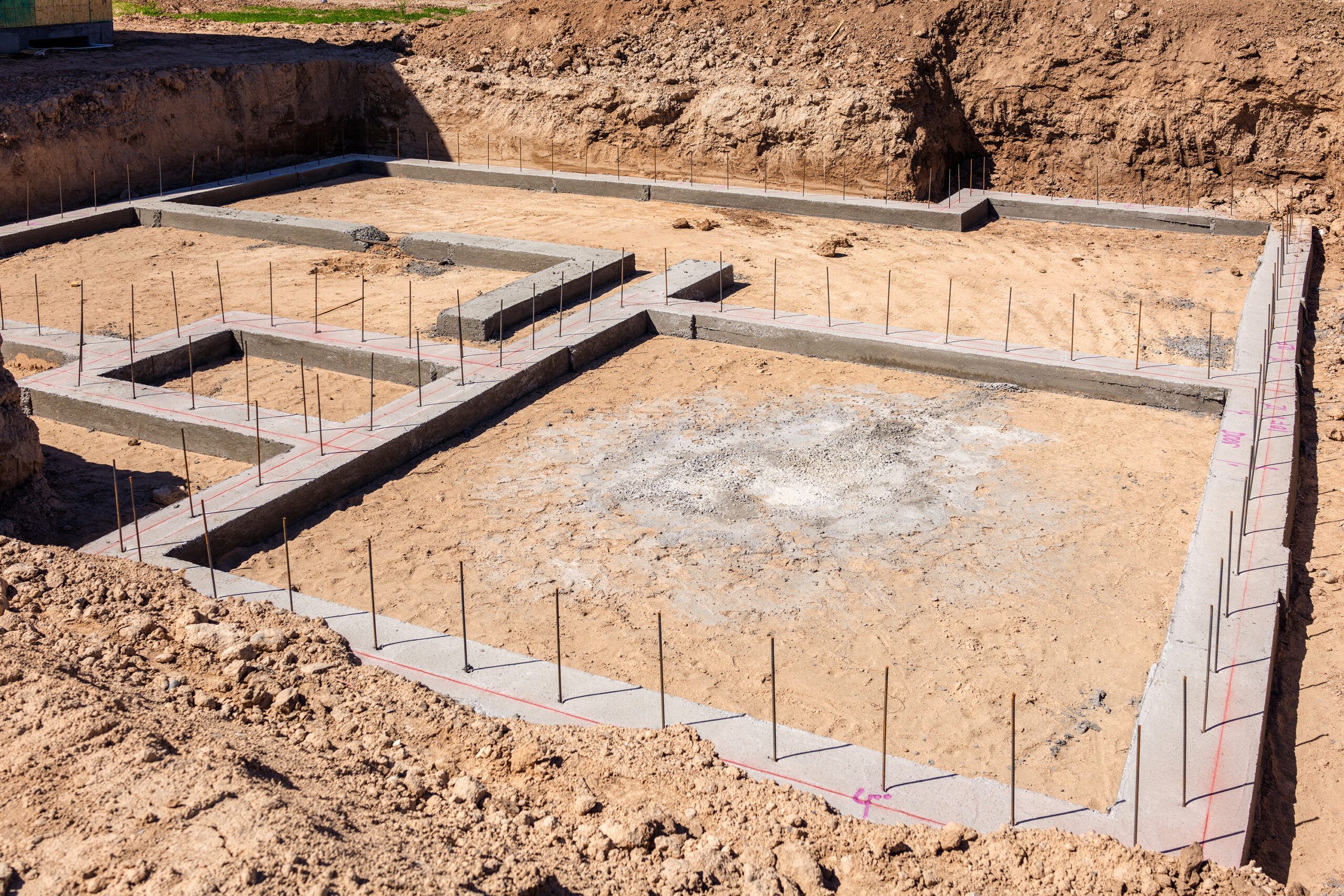A strong foundation is the cornerstone of any well-built home. “Without a good one, you’re sunk,” as This Old House general contractor Tom Silva says.
A proper foundation does more than just hold a house above ground. Foundations distribute the weight of the entire home evenly across the ground and resist the earth’s natural movement, ensuring the home’s stability above. They also create a barrier against cold air and ground moisture, helping to keep basements and crawl spaces dry and interiors warm.
We’ll explore the various types of foundations, key materials used to build them, and recent innovations that ensure your home stands strong for generations to come.
What Are the Main Types of House Foundations?
There are three main types of house foundations, each suited to different climates, soil conditions, and architectural designs. The choice of foundation can significantly impact a home’s energy efficiency, moisture control, and overall stability.
Slab Foundations
Slab foundations are popular in warmer climates and areas with stable soil like clay. They use a single layer of concrete poured directly onto the ground, typically 4-6 inches thick. Slab foundations are cost-effective and quick to install, making them popular for new construction homes.
The requirements for a slab foundation include a sturdy footing and a vapor-proofed concrete pad on a bed of compacted stone. In colder climates, special attention must be given to insulation to protect against frost heave.
Crawl Space Foundations
Crawl space foundations elevate the home slightly off the ground, creating a small space between the first floor and the earth. This type of foundation is common in areas with high water tables or expansive soils. Crawl spaces also provide easy access to plumbing and electrical systems, making maintenance and repairs more convenient.
Basement Foundations
Basement foundations are prevalent in colder climates and when homeowners desire additional living space. They consist of foundation walls that extend below ground level, creating a full-height space beneath the home. You can finish a basement to provide extra living area, storage, or utility space.

Materials for Foundations
A foundation’s strength and longevity depends on the materials used. Modern foundations rely on a combination of robust materials to ensure stability, durability, and moisture resistance.
Concrete is the primary material used in most modern foundations. Its durability and versatility make it ideal for creating long-lasting foundations. Silva prefers steel-reinforced foundation walls and footings made of poured concrete, considering them superior to traditional stone, brick, or concrete block foundations.
Contractors must properly mix, pour, and cure the concrete to achieve the desired strength, typically around 3,000 pounds per square inch (psi). A rushed curing process can weaken the concrete and cause potential foundation problems.
Steel Reinforcement
Steel reinforcement, usually in the form of rebar or wire mesh, enhances the strength and stability of concrete foundations. The steel helps distribute loads and prevents cracking, especially in earthquake-prone areas.
Waterproofing Materials
Effective waterproofing is critical for maintaining a dry and healthy foundation. Materials such as bituminous coatings, polymer-based sealants, and drainage membranes are applied to the exterior of foundation walls to prevent water infiltration. Proper waterproofing extends the life of a foundation and protects the home from moisture-related issues.
The Foundation Construction Process
Building a strong foundation requires careful planning, precise execution, and attention to detail.
- Site preparation and excavation: The first step in foundation construction is preparing the site. This step involves clearing the area, conducting soil tests, and excavating to the appropriate depth. Proper site preparation creates a level base and provides adequate drainage.
- Forming and pouring the foundation: Once the site is prepared, forms are set up to shape the concrete. For poured concrete foundations, completing the pour in one continuous session is crucial to avoid cold joints, which can lead to cracks and leaks.
- Curing and waterproofing: After pouring, the concrete must cure slowly to reach its full strength. This process typically takes several days and requires keeping the concrete damp to ensure proper curing. Once cured, waterproofing materials protect the foundation from moisture intrusion.
What Factors Affect Foundation Design?
Several factors influence how a foundation is constructed. These factors tailor the foundation to the site’s specific needs and climate.
- Climate and weather: Local climate conditions, including temperature fluctuations, rainfall, and frost depth, play a crucial role in foundation design. In colder regions, foundations must extend below the frost line to prevent heaving, while elevated foundations may be necessary in areas prone to flooding.
- Local building codes: Local building codes regulate what foundation design and construction can be used. These codes often specify minimum requirements for foundation depth, materials, and construction methods based on local conditions and best practices.
- Soil composition and stability: Clay-rich or organic soils can retain water, increasing the risk of foundation cracks when the ground freezes and expands. Proper soil analysis is essential for determining the appropriate foundation type and depth.
What Are Common Foundation Problems and Solutions?
Even well-constructed foundations can develop issues over time. You want to address these issues promptly to maintain the integrity of your home.
- Cracks and structural issues: Small cracks in foundations are common and often harmless. However, large or growing cracks can indicate serious structural problems. Regular inspections identify issues early, allowing for timely repairs before they become major problems.
- Settlement and shifting: Some degree of settlement is normal for new constructions. However, excessive or uneven settlement can lead to structural issues. Solutions may include underpinning, mudjacking, or installing piers to stabilize the foundation.
- Water damage and moisture intrusion: Water is one of the biggest threats to foundation health. Proper drainage around the home, including gutters and grading, is a must for preventing water damage. If moisture issues occur, consider installing French drains, applying waterproof coatings, or improving landscape grading.
We recommend visually inspecting your foundation at least annually, looking for signs of cracks, moisture, or shifting. Pay special attention to areas around windows, doors, and where the foundation meets the ground. If you notice any problems, such as cracks, uneven floors, or sticking doors and windows, address them promptly. Early intervention often prevents minor issues from becoming major structural problems.
Also, maintain adequate drainage around your home by keeping gutters clean and ensuring the ground slopes away from the foundation. Drainage prevents water from pooling near your foundation, which leads to damage over time.
Innovations in Foundation Technology
The field of foundation construction is continually evolving, with new technologies offering improved efficiency, strength, and moisture resistance.
Precast Foundation Systems
Precast foundation systems can offer significant time savings and consistent quality. These systems arrive ready to install, eliminating the need for on-site forming and curing.
Self-Leveling Concrete
Advanced plasticizers make self-leveling concrete possible, simplifying the pouring process and ensuring a perfectly level surface. “You can back a truck up to one corner and pour the whole foundation. It just spreads everywhere,” explains Ed Sauter, executive director of the Concrete Foundations Association.
Fabric-Formed Footings
Fabric-formed footings use flexible, high-density polyethylene fabric instead of traditional wooden forms. These systems conform easily to uneven sites, simplify excavation, and provide built-in damp-proofing. The unique shape of fabric-formed footings also helps divert water away from the foundation.
What Is the Cost of Building a Strong Foundation?
A foundation typically accounts for 8%-15% of a home’s total construction cost. Thus, the cost can vary widely based on the size of the home and the type of foundation being built.
A simple slab foundation for a small home could cost as little as $5,000 or up to $16,000, according to Angi. A basement for a mid-sized home could run $40,000 to $74,000, per Angi.
But investing in a quality foundation is well worth the cost, since the structure is crucial for your home’s long-term stability and value.
Here are the factors that can affect foundation cost:
- Type of foundation (slab, crawl space, or basement)
- The size and depth of the foundation
- Soil conditions and necessary site preparation
- Local labor and material costs
- Additional features like waterproofing or insulation
Our Conclusion
A sturdy foundation offers long-term stability and value to your home. Whether constructing a new home or maintaining an existing one, prioritizing a high-quality foundation will bring long-lasting benefits.

